The Main Controlling Factors of Glutenite Development and Their Impacts on Oil Energy Extraction
Abstract
:1. Introduction
2. Geological Background
2.1. Location and Strata
2.2. Types of Glutenite Fans
3. Methods
3.1. Fault Characteristics
3.2. Fault Throw
3.3. Incised Valley Development
4. Results
4.1. Fault-Glutenite Types and Characteristics
4.2. Fault Throw
4.3. Incised Valley
4.3.1. Incised Valley Types
4.3.2. Incised Valley Features
5. Discussion
5.1. Fault Characteristics Control Glutenite Development
5.1.1. Fault Characteristics
- (1)
- Types of boundary faults
- (2)
- Stratigraphic occurrence of fault footwall block
- (3)
- Lithologies on the hanging wall of faults
5.1.2. Fault-Ramp Control Glutenite Fan Type
5.1.3. The Fault Characteristics Control the Glutenite Acreage
5.2. Fault Throw Controls the Thickness of Glutenite
5.3. Incised Valleys Control the Transport Capacity of Glutenite
5.4. Example of Energy Exploitation
6. Conclusions
- Fault ramps control the glutenite fan type. Different faults have different water depths, which determine the type of glutenite. The footwalls of planar and listric faults mainly developed nearshore underwater fans. The upper steps of step faults mainly developed nearshore underwater fans; in the lower step, the was deeper, and mostly turbidite fans developed. The upper steps of ramp-flat faults mainly developed alluvial fans and fan delta plain deposits, the second steps (middle steps) developed nearshore underwater fans and fan delta fronts, and the third steps (lower steps) developed deep-water turbidite fans and slump turbidity.
- The morphology of the footwall block of a fault in the study area could be divided into convex and concave, and glutenite developed on a large scale on concave strata. The lithology of the hanging wall of the fault could be divided into granite and clastic rock. A granite hanging wall corresponded to a small-scale glutenite body, and a hanging wall with clastic rock corresponded to a large-scale glutenite body.
- Incised valleys control the transport and provide channels for the migration of glutenite. According to their shapes, there were wide-deep types, wide-shallow types, narrow-deep types, and narrow-shallow types. According to the relationship between the depth of the proximal valley near the glutenite in the mature exploration area and the thickness, width, and length of the glutenite, the transport index represents a method to predict the distribution range and thickness of glutenite by using the depth of nearby incised valleys. Six main incised valleys were developed in the northern part of Guojuzi, among which four incised valleys in the west had relatively small sediment supply capacities, while the eastern incised valleys 5 and 6 had relatively large sediment supply capacities.
- Based on the analysis of the relationship between the main controlling factors of glutenite and oil productivity, this paper established an evaluation standard for glutenite reservoirs in the study area. The reservoir was divided into a high production area, medium production area and low production area. The high production area was located in the clastic rock hanging wall fault area, the daily average oil production was more than 25 t, the fault throw was more than 1200 m, and the thickness and width of the incised valley were more than 85 m and 2400 m, respectively. The middle production area was located in the clastic rock area, the daily average oil production was 10–25 t, the fault throw was 780–1200 m, and the thickness and width of the incised valley were 55–85 m and 1200–2400 m, respectively. The low production area was located in the granite hanging wall fault area, the daily average oil production was less than 10 t, the fault throw was less than 780 m, and the thickness and width of the incised valley were less than 55 m and 1200 m, respectively. Under the guidance of this standard, it is predicted that the area around well C918 in the southeast was the high production area. Newly developed oil wells in high-yield areas had a daily oil production rate of 88 t/d, and the oil energy production effect was very good. Therefore, the main controlling factors of conglomerate development were of great significance to the oil production of similar reservoirs. Therefore, the main controlling factors of glutenite were of great significance to oil extraction.
Author Contributions
Funding
Conflicts of Interest
References
- Earle, S. Physical Geology, 2nd ed.; BCcampus: Victoria, BC, Canada, 2015; pp. 148–152. [Google Scholar]
- Wang, Y.G.; Yang, G.Q. Analysis on geophysical characteristics of glutenite reservoir. J. China Univ. Pet. 2001, 25, 16–20. [Google Scholar] [CrossRef]
- Matenco, L.; Andriessen, P. The Source sink network, Quantifying the mass transfer from mountain ranges to deposition in sedimentary basins: Source to sink studies in the Danube Basin–Black Sea system. Glob. Planet. Chang. 2013, 103, 1–18. [Google Scholar] [CrossRef]
- Genik, G.J. Petroleum geology of Cretaceous-Tertiary rift basins in Niger, Chad, and Central African Republic. AAPG Bull. 1993, 8, 1405–1434. [Google Scholar] [CrossRef]
- Marr, J.G.; Swenson, J.B.; Paola, C.; Voller, V.R. A two-diffusion model of fluvial stratigraphy in closed depositional basins. Basin Res. 2000, 12, 381–398. [Google Scholar] [CrossRef]
- Sømme, T.O.; Jackson, C.A.-L.; Vaksdal, M. Source-to-sink analysis of ancient sedimentary systems using a subsurface case study from the Møre-Trøndelag area of southern Norway: Part 1—Depositional setting and fan evolution. Basin Res. 2013, 25, 489–511. [Google Scholar] [CrossRef]
- Sømme, T.O.; Jackson, C.A.-L. Source-to-sink analysis of ancient sedimentary systems using a subsurface case study from the Møre-Trøndelag area of southern Norway: Part 2—Sediment dispersal and forcing mechanisms. Basin Res. 2013, 25, 512–531. [Google Scholar] [CrossRef]
- Li, L.; Zhai, M.; Zhang, L.; Zhang, Z.; Huang, B.; Li, A.; Zuo, J.; Zhang, Q. Brittleness Evaluation of Glutenite Based on Energy Balance and Damage Evolution. Energies 2019, 12, 3421. [Google Scholar] [CrossRef] [Green Version]
- Wang, Y.Z.; Song, G.Q.; Wang, X.Z. Index of provenance provision and its controlling action on the development of the beach and bar. Pet. Geol. Oilfield Dev. Daqing 2013, 32, 49–53. [Google Scholar] [CrossRef]
- Zhou, L.; Fu, L.; Lou, D.; Lu, Y.; Feng, J.; Zhou, S.; Santosh, M.; Li, S. Structural anatomy and dynamics of evolution of the Qikou Sag, Bohai Bay Basin: Implications for the destruction of North China craton. J. Asian Earth Sci. 2012, 47, 94–106. [Google Scholar] [CrossRef]
- Hornung, J.; Pflanz, D.; Hechler, A.; Beer, A.; Hinderer, M.; Maisch, M.; Bieg, U. 3-D architecture, depositional patterns and climate triggered sediment fluxes of an alpine alluvial fan (Samedan, Switzerland). Geomorphology 2010, 115, 202–214. [Google Scholar] [CrossRef]
- Nava-Sanchez, E.; Cruz-Orozco, R.; Gorsline, D.S. Morphology and sedimentology of two contemporary fan deltas on the southeastern Baja California Peninsula, Mexico. Sediment. Geol. 1995, 98, 45–61. [Google Scholar] [CrossRef]
- Soh, W.; Tanaka, T.; Taira, A. Geomorphology and sedimentary processes of a modern slope-type fan delta (Fujikawa fan delta), suruga trough, Japan. Sediment. Geol. 1995, 98, 79–95. [Google Scholar] [CrossRef]
- Pomar, F.; Del Valle, L.; Fornós, J.; Gomez-Pujol, L. Late Pleistocene dune–sourced alluvial fans in coastal settings: Sedimentary facies and related processes (Mallorca, Western Mediterranean). Sediment. Geol. 2018, 367, 48–68. [Google Scholar] [CrossRef]
- Kain, C.L.; Rigby, E.H.; Mazengarb, C. A combined morphometric, sedimentary, GIS and modelling analysis of flooding and debris flow hazard on a composite alluvial fan, Caveside, Tasmania. Sediment. Geol. 2018, 364, 286–301. [Google Scholar] [CrossRef]
- Davor, P.; Marijan, K. Lower Miocene Alluvial Deposits of the Pozeska Mt. (Pannonian Basin, Northern Croatia): Cycles, Megacycles and Tectonic Implications. Geol. Croat. 1999, 52, 67–76. [Google Scholar] [CrossRef]
- Tanaka, J.; Maejima, W. Fan-delta sedimentation on the basin margin slope of the Cretaceous, strike-slip Izumi Basin, southwestern Japan. Sediment. Geol. 1995, 98, 205–213. [Google Scholar] [CrossRef]
- Cabello, P.; Falivene, O.; López-Blanco, M.; Howell, J.A.; Arbués, P.; Ramos, E.; López, P.C. An outcrop-based comparison of facies modelling strategies in fan-delta reservoir analogues from the Eocene Sant Llorenç del Munt fan-delta (NE Spain). Pet. Geosci. 2011, 17, 65–90. [Google Scholar] [CrossRef]
- Liu, B.; Tan, C.; Yu, X.; Qu, J.; Zhao, X.; Zhang, L. Sedimentary characteristics and controls of a retreating, coarse-grained fan-delta system in the Lower Triassic, Mahu Depression, northwestern China. Geol. J. 2019, 54, 1141–1159. [Google Scholar] [CrossRef]
- Bestland, E.A. A Miocene Gilbert-type fan-delta from a volcanically influenced lacustrine basin, Rusinga Island, Lake Victoria, Kenya. J. Geol. Soc. 1991, 148, 1067–1078. [Google Scholar] [CrossRef]
- Jia, J.; Liu, Z.; Miao, C.; Fang, S.; Zhou, R.; Meng, Q.; Chen, Y.; Yan, L.; Yang, D. Depositional model and evolution for a deep-water sublacustrine fan system from the syn-rift Lower Cretaceous Nantun Formation of the Tanan Depression (Tamtsag Basin, Mongolia). Mar. Pet. Geol. 2014, 57, 264–282. [Google Scholar] [CrossRef]
- Kim, J.; Chough, S. A gravel lobe deposit in the prodelta of the Doumsan fan delta (Miocene), SE Korea. Sediment. Geol. 2000, 130, 183–203. [Google Scholar] [CrossRef]
- McConnico, T.; Bassett, K.N. Gravelly Gilbert-type fan delta on the Conway Coast, New Zealand: Foreset depositional processes and clast imbrications. Sediment. Geol. 2007, 198, 147–166. [Google Scholar] [CrossRef]
- Shanmugam, G. 50 years of the turbidite paradigm (1950s–1990s): Deep-water processes and facies models—a critical perspective. Mar. Pet. Geol. 2000, 17, 285–342. [Google Scholar] [CrossRef]
- Kubo, Y.; Nakajima, T. Laboratory experiments and numerical simulation of sediment-wave formation by turbidity currents. Mar. Geol. 2002, 192, 105–121. [Google Scholar] [CrossRef]
- Huang, Y. Sedimentary characteristics of turbidite fan and its implication for hydrocarbon exploration in Lower Congo Basin. Pet. Res. 2018, 3, 189–196. [Google Scholar] [CrossRef]
- Zhao, Y.; Dai, J.S. Identification of growth fault by fault fall analysis. Pet. Explor. Dev. 2003, 30, 13–15. [Google Scholar] [CrossRef]
- Stephen, A.D. Holmes’ Principles of Physical Geology. Geol. Mag. 1993, 130, 549. [Google Scholar] [CrossRef]
- Willemse, E.J.; Peacock, D.C.; Aydin, A. Nucleation and growth of strike-slip faults in limestones from Somerset, U.K. J. Struct. Geol. 1997, 19, 1461–1477. [Google Scholar] [CrossRef]
- Withjack, M.O.; Schlische, R.W.; Olsen, P.E.; Ashley, G.M. Rift-Basin Structure and Its Influence on Sedimentary Systems. Sediment. Continental Rifts 2002, 73, 57–81. [Google Scholar] [CrossRef] [Green Version]
- Gong, Z.; Zhu, W.; Chen, P.P.-H. Revitalization of a mature oil-bearing basin by a paradigm shift in the exploration concept. A case history of Bohai Bay, Offshore China. Mar. Pet. Geol. 2010, 27, 1011–1027. [Google Scholar] [CrossRef]
- Xie, X.; Cui, T.; Dietmar, M.R.; Gong, Z.; Guo, X.; Liu, X.; Zhang, C. Subsidence history and forming mechanism of anomalous tectonic subsidence in the Bozhong depression, Bohaiwan basin. Sci. China Ser. D Earth Sci. 2007, 50, 1310–1318. [Google Scholar] [CrossRef]
- Peacock, D.; Nixon, C.; Rotevatn, A.; Sanderson, D.; Zuluaga, L. Glossary of fault and other fracture networks. J. Struct. Geol. 2016, 92, 12–29. [Google Scholar] [CrossRef]
- Xu, J.R.; Zhao, Z.X.; Ishikawa, Y.Z. Regional characteristics of crustal stress field and tectonic motions in and around Chinese mainland. Chin. J. Geophys. 2008, 51, 770–781. [Google Scholar] [CrossRef]
- Malvić, T. Middle Miocene Depositional Model in the Drava Depression Described by Geostatistical Porosity and Thickness Maps (Case study: Stari Gradac-Barcs Nyugat Field). Rud. Geol Naft. Zb. 2006, 18, 63–70. [Google Scholar]
- Sremac, J.; Velić, J.; Bošnjak, M.; Velić, I.; Kudrnovski, D.; Troskot-Čorbić, T. Depositional Model, Pebble Provenance and Possible Reservoir Potential of Cretaceous Conglomerates: Example from the Southern Slope of Medvednica Mt. (Northern Croatia). Geosciences 2018, 8, 456. [Google Scholar] [CrossRef] [Green Version]
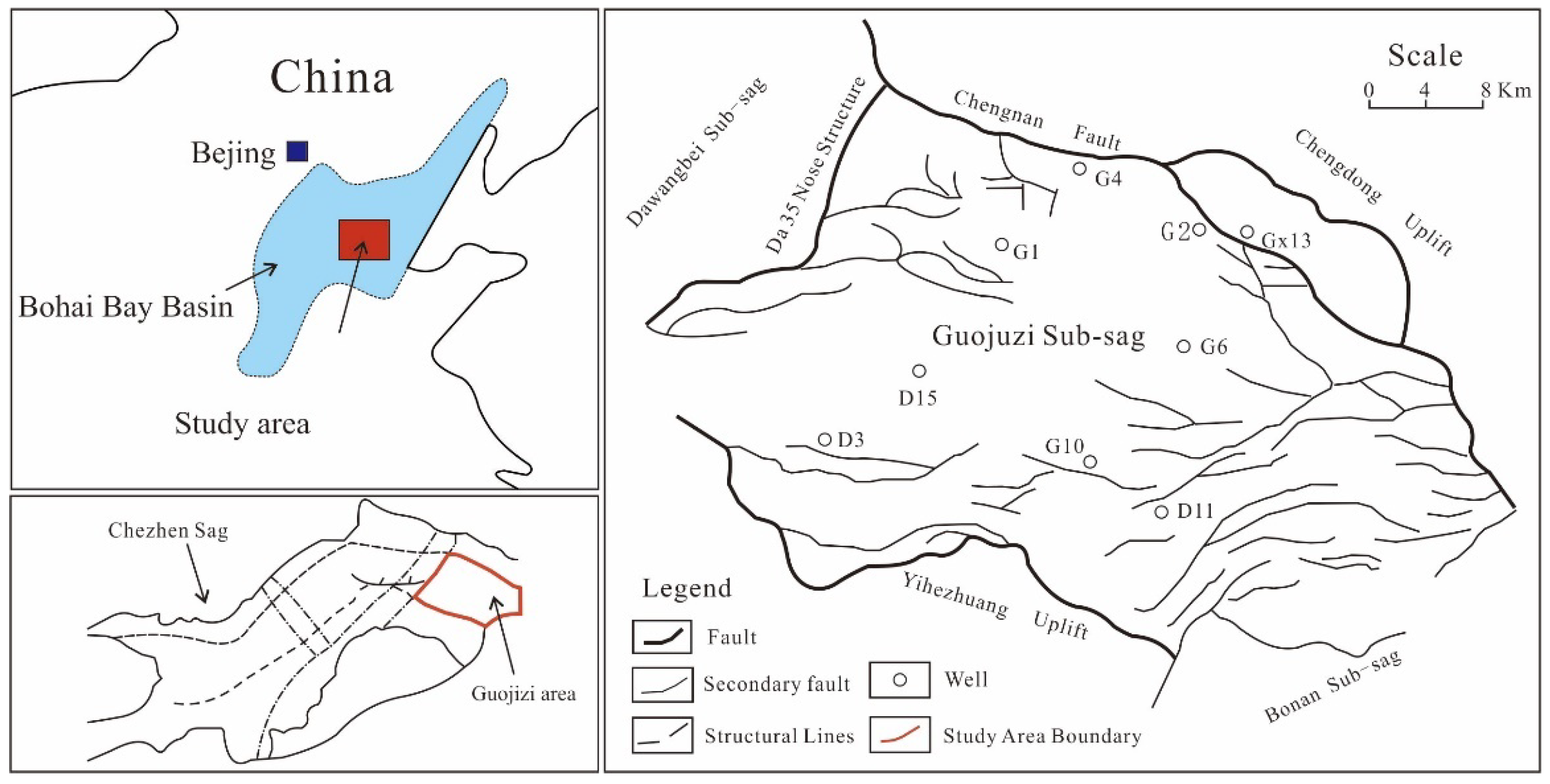

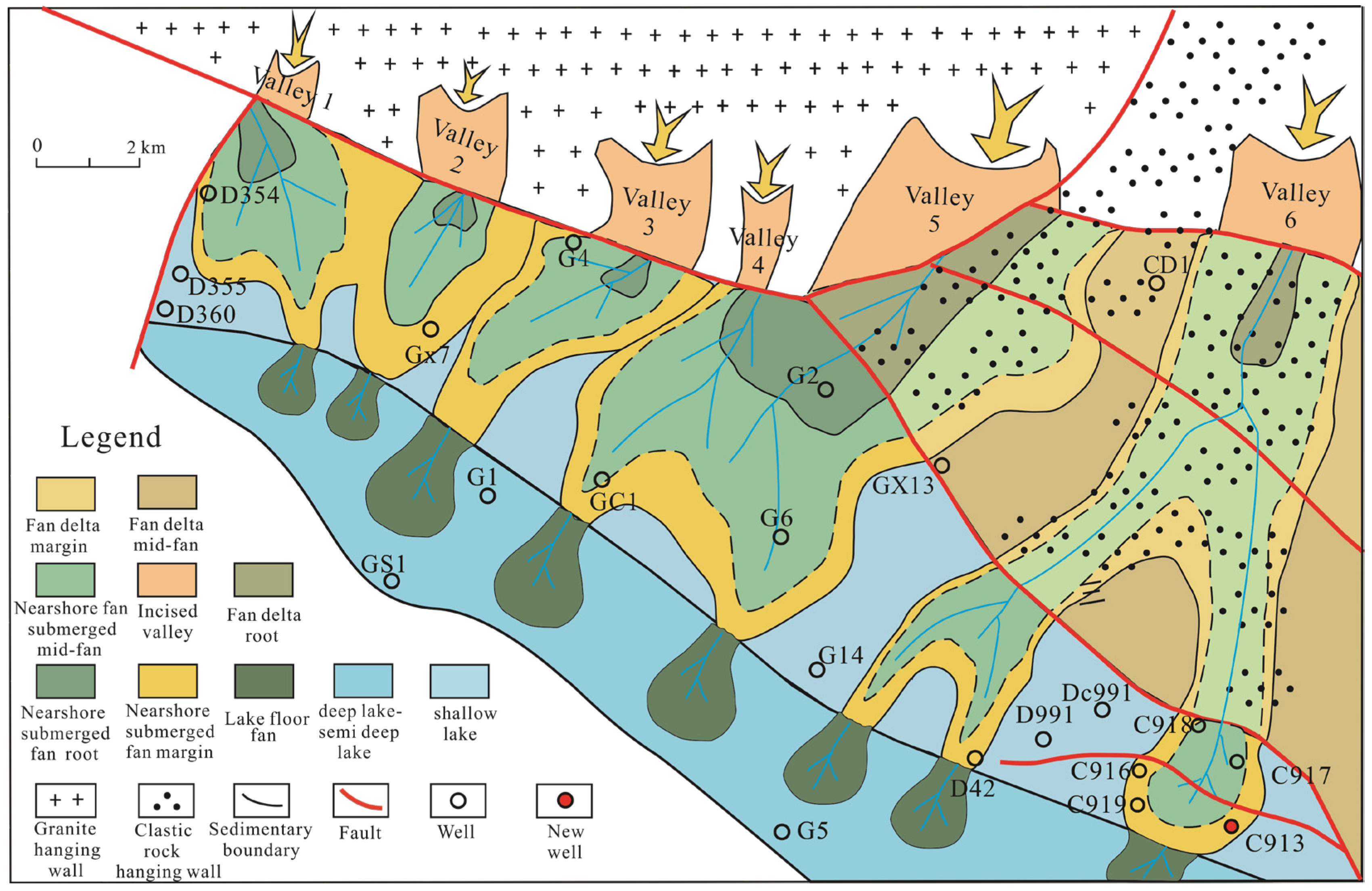
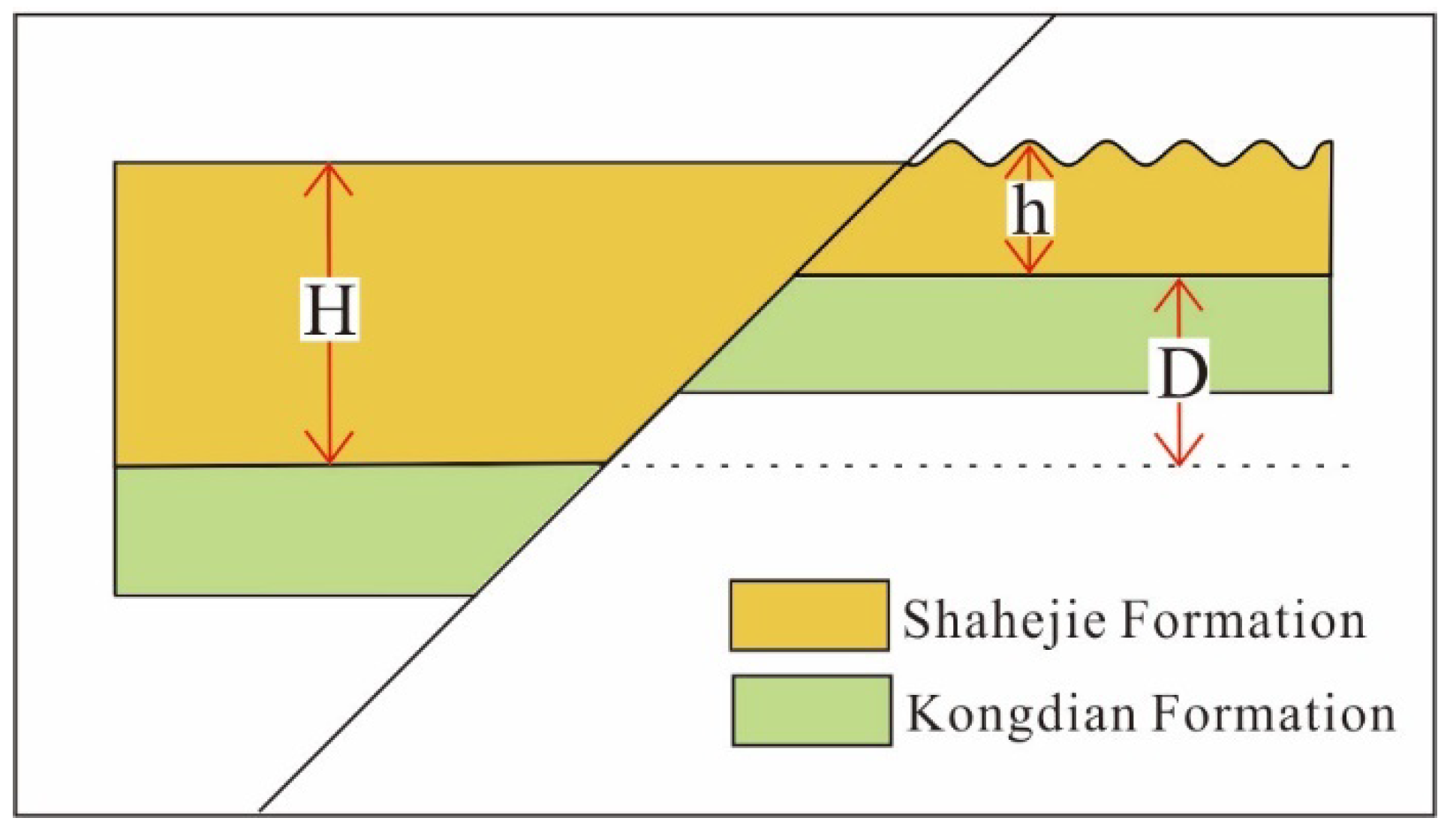
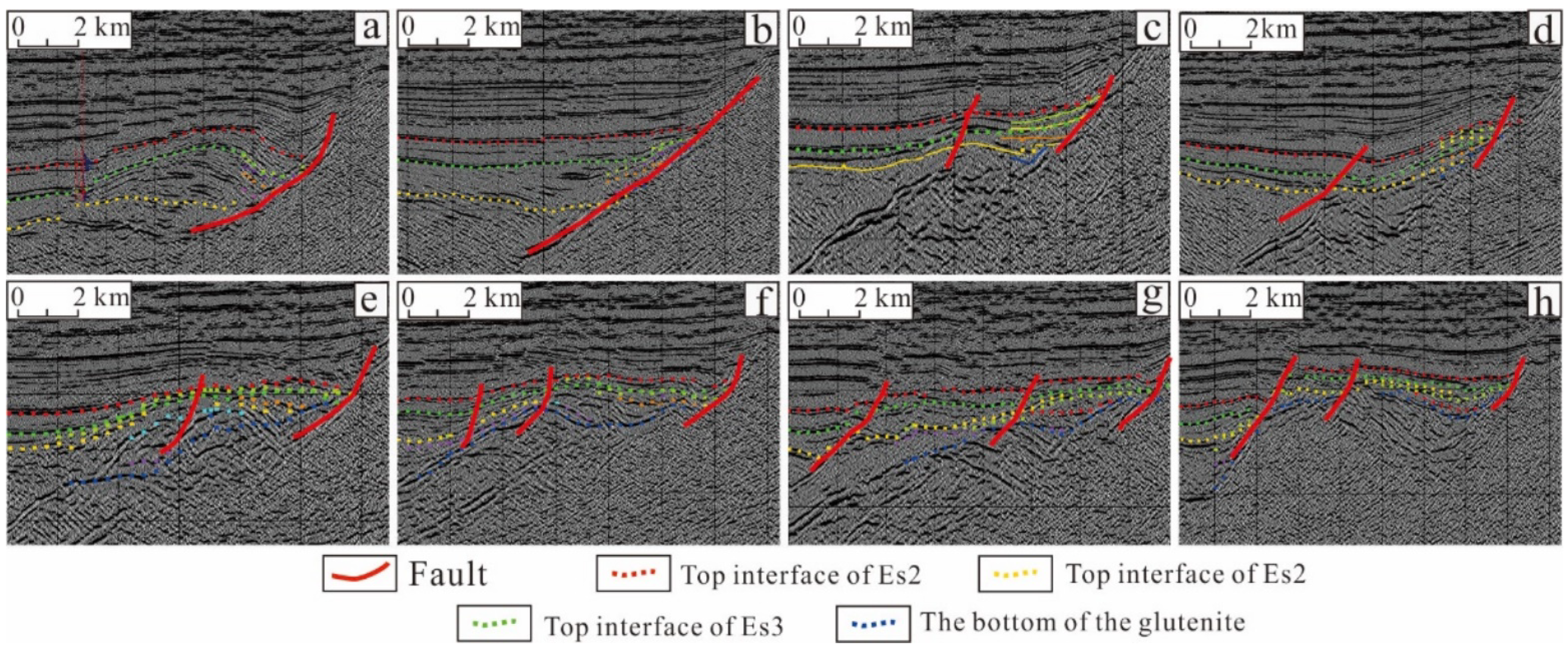
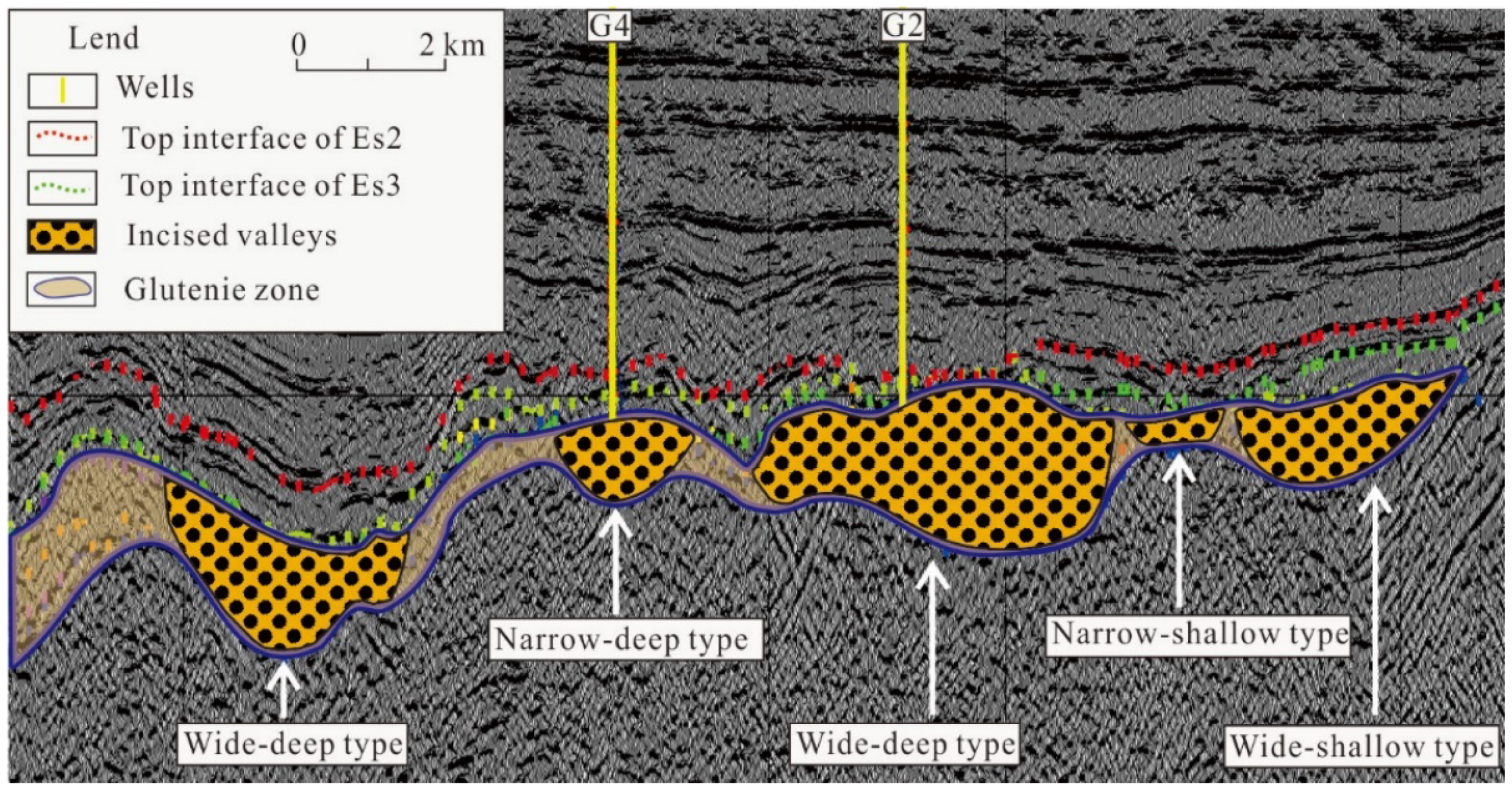
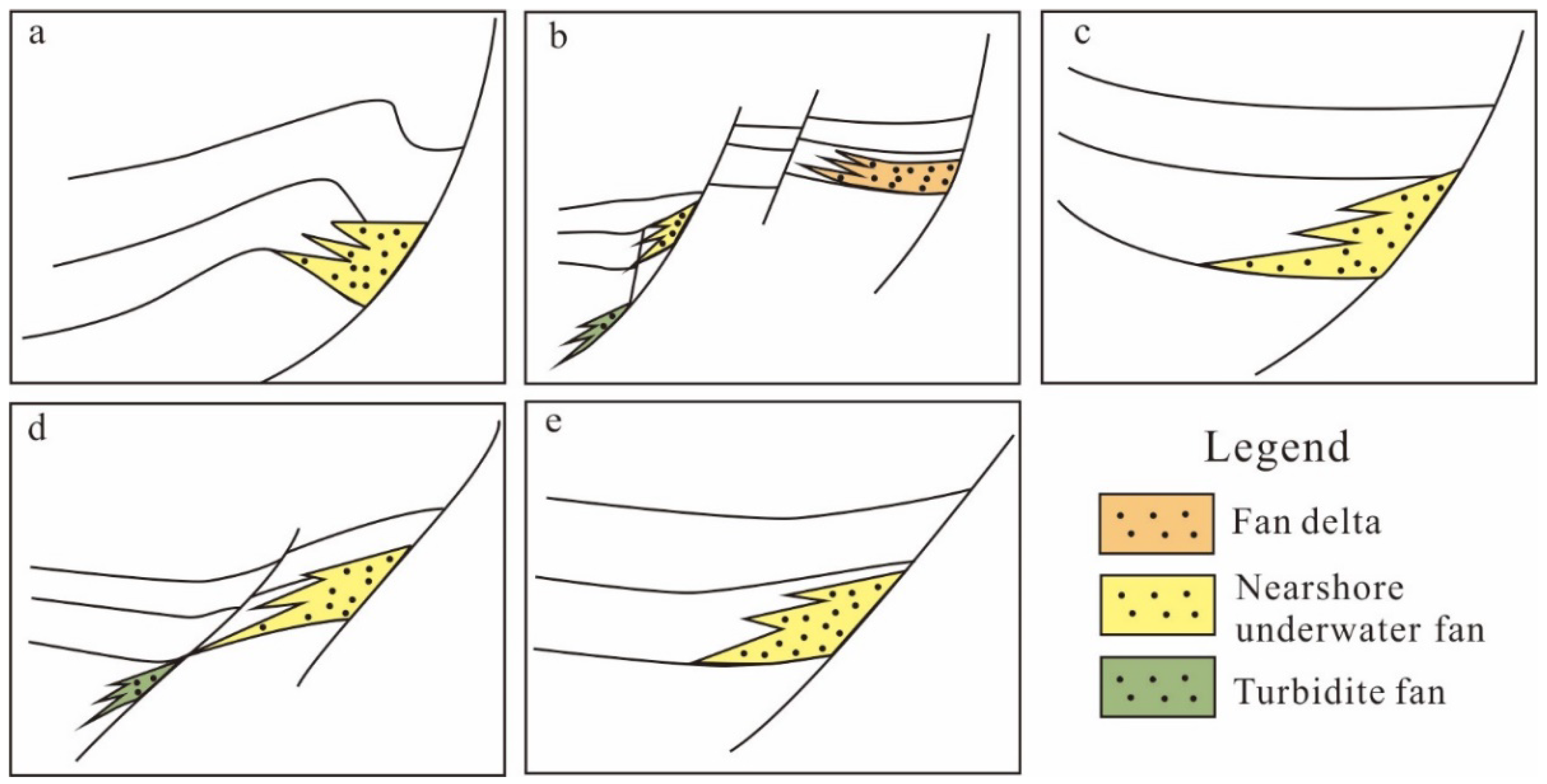

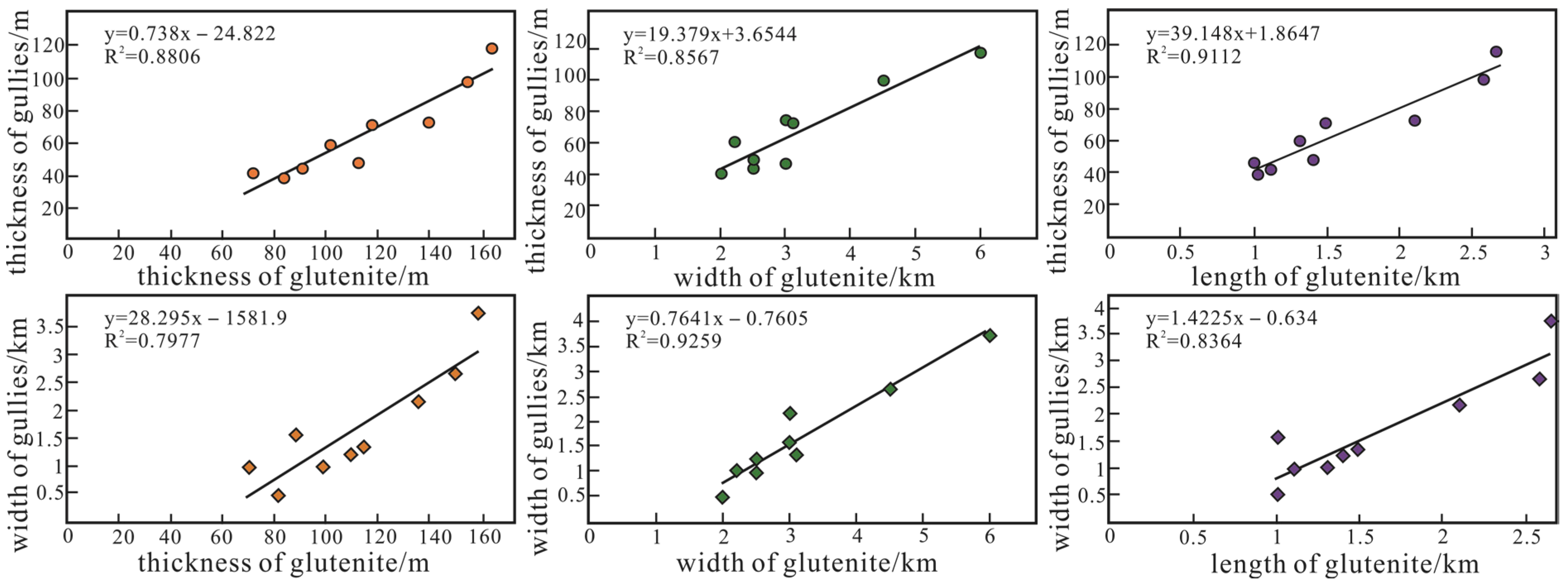
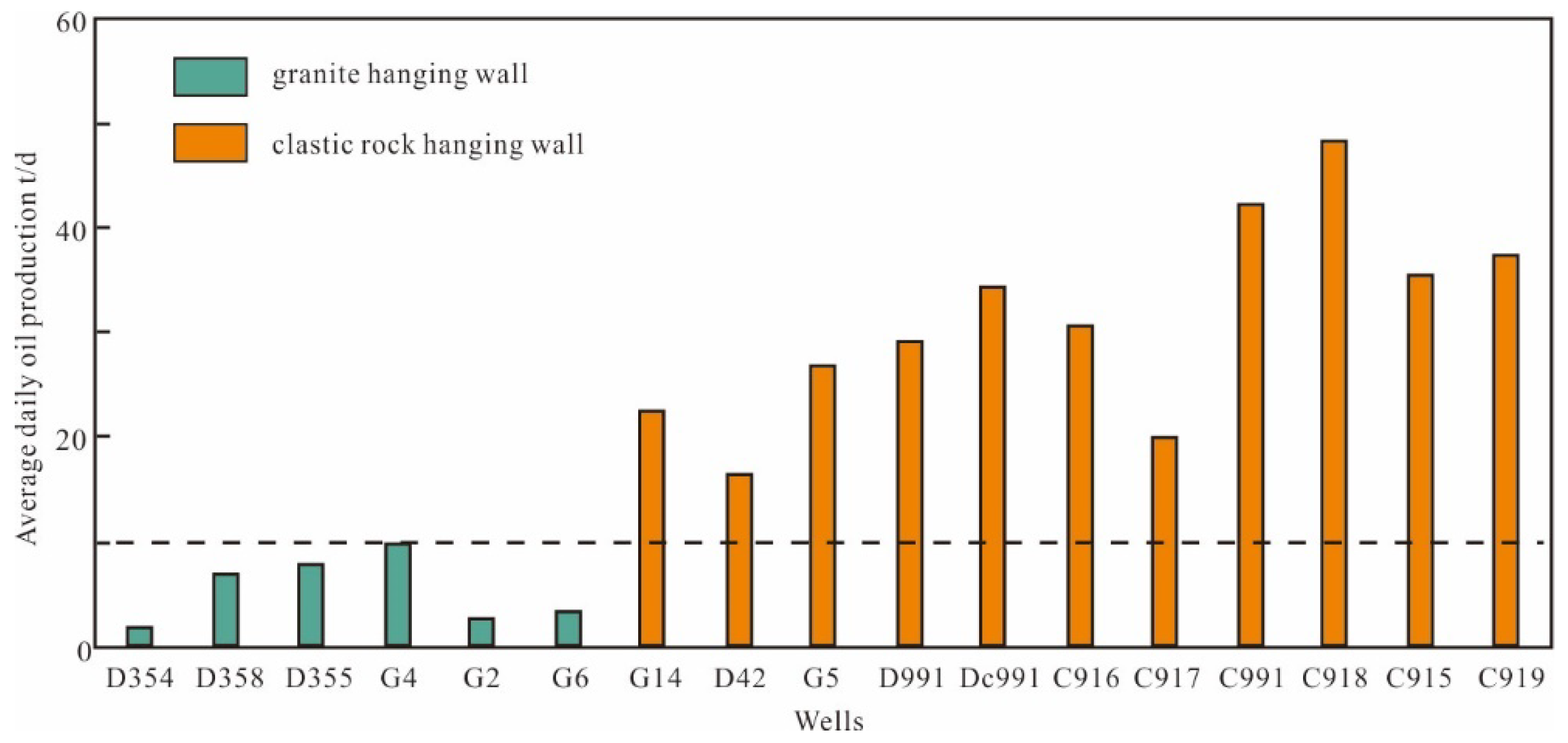

| Fault Type | Foot Wall Block Occurrence | Hanging Wall Block Lithology | Glutenite Fan Type | Glutenite Scale |
|---|---|---|---|---|
| Planar fault | Convex | Clastic rock | Alluvial fan | Large |
| Listric fault | Fan delta | |||
| Step fault | Concave | Granite | Nearshore underwater fan | Small |
| Ramp-flat fault | Turbidite fan |
| Glutenite Type | Incised Valley Thickness/m | Incised Valley Width/m |
|---|---|---|
| Wide-deep | 70–120 | >2000 |
| Narrow-deep | 50–100 | 1000–1500 |
| Wide-shallow | 30–50 | 1500–2000 |
| Narrow-shallow | 30–50 | <1000 |
| Fault Types | Glutenite Scale | Strata Occurrence | Seismic Emission Characteristics | Hanging Wall Lithology | Glutenite Developmental Position |
|---|---|---|---|---|---|
| Listric fault | Small | Convex | High-angle oblique | Granite | At the slope |
| Planar fault | Small | Concave | Low-angle oblique | Granite | At the slope |
| Step fault | Small | Concave | High-angle oblique | Granite | In the fault corner |
| Step fault | Small | Convex | Low-angle oblique | Granite | Near the fault side of the step |
| Ramp-flat fault | Mid-small- | Convex | Low-angle oblique | Granite | Near the fault side of the slope |
| Step fault | Large | Convex | Mound-shaped | Clastic rock | Near the fault side of the step |
| Ramp-flat fault | Large | Convex | Lamellar-shaped | Clastic rock | At the foot of the slope |
| Step fault | Large | Concave | Lenticular-shaped | Clastic rock | In the groove |
| Well | Layer | Fault Throw/m |
|---|---|---|
| G2 | S2 | 855.1 |
| G2 | S3 | 916.9 |
| G2 | S4 | 1342.8 |
| G6 | S2 | 310.5 |
| G6 | S3 | 436.6 |
| G4 | S2 | 1047.3 |
| G4 | S3 | 1278 |
| C913 | S3 | 1311.2 |
| C913 | S3 | 1192 |
| Well | Incised Valley Thickness/m | Incised Valley Width/m | Type |
|---|---|---|---|
| D354 | 39 | 482 | Narrow-shallow |
| G4 | 73 | 2170 | Wide-deep |
| G2 | 116 | 3750 | Wide-deep |
| G6 | 45 | 1565 | Wide-shallow |
| GX13 | 71 | 1340 | Narrow-deep |
| G14 | 48 | 1220 | Narrow-shallow |
| CD3 | 59 | 998 | Narrow-deep |
| C913 | 98 | 2660 | Wide-deep |
| C918 | 42 | 976 | Narrow-shallow |
| Fault Feature Type | Glutenite Development Area/km2 |
|---|---|
| Listric-convex-granite type | 0.08 |
| Planar-concave-granite type | 0.13 |
| Step-concave-granite type | 0.17 |
| Step-convex-granite type | 0.09 |
| Ramp-flat-convex-granite type | 0.26 |
| Step-convex-clastic rock type | 0.94 |
| Gentle slope-convex-clastic rock type | 1.42 |
| Step-concave-clastic rock type | 3.47 |
| Reservoir Evaluation Parameters | Daily Average Oil Production (t/d) | Main Controlling Factors of Glutenite Reservoir | Conventional Reservoir Parameters | ||||
|---|---|---|---|---|---|---|---|
| Hanging Wall Lithology | Fault Throw (m) | Incised Valley Thickness (m) | Incised Valley Width (m) | Porosity (%) | Permeability (×10−3 μm2) | ||
| High oil production area | >25 | Clastic rock | >1200 | >85 | >2400 | >12 | >3 |
| Medium oil production area | 10–25 | Clastic rock | 780–1200 | 55–85 | 1200–2400 | 10–2.7 | 0.2–3.2 |
| Low oil production area | <10 | Granite | <780 | <55 | <1200 | <5.1 | <0.4 |
Publisher’s Note: MDPI stays neutral with regard to jurisdictional claims in published maps and institutional affiliations. |
© 2021 by the authors. Licensee MDPI, Basel, Switzerland. This article is an open access article distributed under the terms and conditions of the Creative Commons Attribution (CC BY) license (http://creativecommons.org/licenses/by/4.0/).
Share and Cite
Wang, Y.; Dong, C.; Lin, C.; Hou, Q. The Main Controlling Factors of Glutenite Development and Their Impacts on Oil Energy Extraction. Energies 2021, 14, 1807. https://doi.org/10.3390/en14071807
Wang Y, Dong C, Lin C, Hou Q. The Main Controlling Factors of Glutenite Development and Their Impacts on Oil Energy Extraction. Energies. 2021; 14(7):1807. https://doi.org/10.3390/en14071807
Chicago/Turabian StyleWang, Yuping, Chunmei Dong, Chengyan Lin, and Qingjie Hou. 2021. "The Main Controlling Factors of Glutenite Development and Their Impacts on Oil Energy Extraction" Energies 14, no. 7: 1807. https://doi.org/10.3390/en14071807






